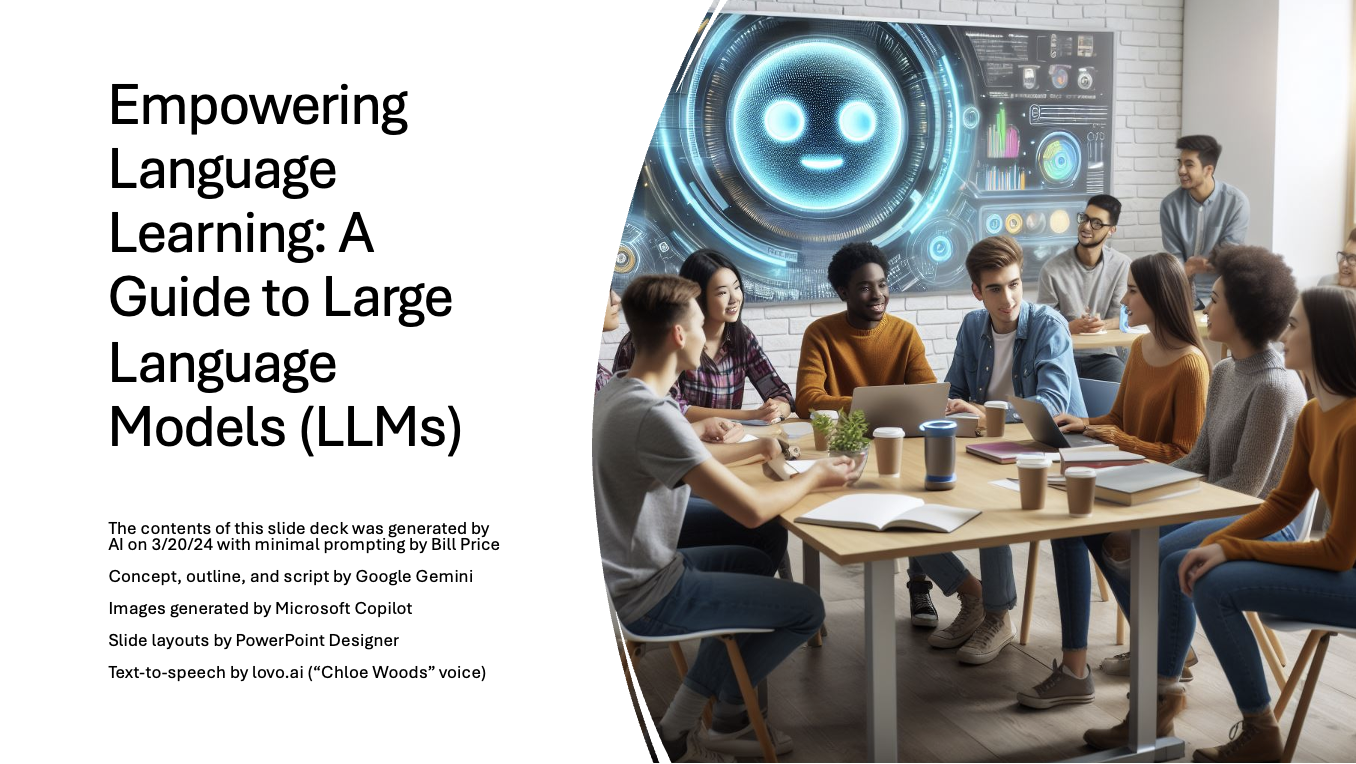Let’s Demystify AI and Take Initiative: A Workshop By and For Educators
Bill Price, with AI assistance
Introduction
Generative AI has exploded into the public consciousness over the last year and a half, including text-based tools such as ChatGPT and image-based tools such as DALL·E. However, many educators remain unsure of how (or whether) to make use of this new class of tools. If we adopt a “wait-and-see” stance to these emerging tools, however, we risk surrendering our professional initiative to people unfamiliar with the classroom environment, such as policymakers and commercial interests.
In this workshop, I argue that we as educators can improve our working conditions (and our students’ learning conditions) if we engage in personal, direct, open exploration of generative AI tools. By the end of this workshop, I hope you will have a stronger understanding of what generative AI tools are; how they work; and how to explore their uses in your educational praxis.
Presentation by “Artificial Guest Speaker”

From Hesitation to Action
Dipping Our Toes In
-
It’s hard to know where to start: See the demos and “additional resources” sections below for lists of tools and examples of their usage.
-
Overcoming Barriers: The best ways to build confidence in generative AI tools are to cultivate a sense of what’s possible by exploring others’ work and to develop hands-on experience through personal experimentation with the tools.
Our Role as Professionals
-
Take the Reins: As professionals, it’s up to us to take initiative to establish best practices for emerging tools.
-
Guide the Future: Our judgment and expertise is needed to guide the ethical and impactful integration of AI in education.
-
We’re Not In It Alone: As with other forms of educational praxis, we should innovate openly and collectively.
Interactive Demo & Hands-On Exploration
Live Demonstrations
We will briefly visit these four resources:
Based on prior request, we will explore these specific prompts as time allows:
- Writing coach
- Argumentative Essay Draft Feedback
- Generate Vocabulary Images
- Generate Vocabulary Texts/Sentences
Hands-on Exploration
- Feel free to log into one of the “Chat-Based Generative AI Tools” listed in the “Additional Resources” section below. You may copy, modify, and remix any of the above demonstration prompts or explore others from LLM Prompts for Education.
Conclusion
-
The Future Begins Today: Let’s not wait for commercial interests to reshape the landscape of education around us. We should embrace our role as professionals and act as leaders in the innovative use of technology in teaching and learning.
-
Collective Empowerment: Our exploration and adoption of AI tools are not just individual pursuits, but a collective journey towards enhancing educational praxis. Sharing our findings and best practices enriches the entire educational community.
-
The Power of Possibility: As we’ve seen today, the potential applications of generative AI in education are vast and varied. Let’s continue to experiment, innovate, and share, driven by the belief that together, we can redefine the boundaries of what’s possible in education.
Additional Resources
Prompt engineering and repositories
- Here is one common framework for how to assign a task to a conversational AI:
- Tell it who you are. Example: “I’m an ESL instructor developing study materials.”
- Tell it what the project is. Example: “I’m looking for texts that effectively illustrate the meanings of target vocabulary words for my students.”
- Tell it what you want it to do. Example: “I want you to write a paragraph that uses each of these target vocabulary words one time.”
- Tell it how to write the output. Example: “The paragraph should be about … The level of complexity should be … Use/avoid this grammar …”
-
How to Write Better ChatGPT Prompts: Article and video by Leila Gharani with specific tips and examples for writing more effective prompts
-
LLM Prompts for Education: Bill Price’s repository of prompts.
-
Fabric: A repository of prompts by Daniel Miessler. They are not specific to education, but provide excellent examples of what an engineered prompt can look like. See some of Miessler’s examples below:
-
Create Keynote prompt that instructs the AI to create a slide-by-slide plan for a presentation
-
Extract Wisdom prompt that instructs the AI to “extract surprising, insightful, and interesting information from text content”
-
Chat-Based Generative AI Tools (as of March 2024)
Commercial (online)
-
ChatGPT: A conversational AI developed by OpenAI, capable of generating human-like text responses. It’s known for its wide range of applications, from answering questions to writing creative content.
-
Google Gemini: A conversational AI developed by Google, designed to provide information and perform tasks through natural language understanding.
-
Microsoft Copilot: Microsoft’s conversational AI assistant that integrates with various Microsoft products to enhance productivity by automating tasks, generating content, and providing insights based on natural language prompts.
Open-Source (offline)
-
GPT4All: A free program for downloading and running open-source conversational AIs locally on your own computer. As of March 2024, I recommend using the model called Nous Hermes 2 Mistral DPO.
-
LM Studio: Similar to GPT4All, but considered to be less user-friendly and more advanced.
Image-Based Generative AI Tools
-
DALL·E 3: A model by OpenAI that can generate detailed images from textual descriptions, offering creative possibilities in visual content creation.
-
Midjourney: An independent research lab’s image synthesis tool that explores new mediums of thought and expands the imaginative powers of the human species.
-
Stable Diffusion: A text-to-image AI by Stability AI that enables users to create images from textual descriptions, emphasizing accessibility and ease of use.